GE Medical Systems Information Technologies 340T Model 340 Medical Telemetry Transmitter User Manual TRANSMITTER
GE Medical Systems Information Technologies Inc. Model 340 Medical Telemetry Transmitter TRANSMITTER
Contents
- 1. User Manual
- 2. Module User Manual
Module User Manual

ST500
TRANSMITTER
TECHNICAL MANUAL
(1891 1210)
© Copyright Wood & Douglas Ltd 1998
version: 1.0
issue: November 1998
LATTICE HOUSE
BAUGHURST ROAD
TADLEY
HAMPSHIRE
UK RG26 5LP
Tel: +44 (0)118 981 1444 Fax:+44 (0)118 981 1567
1.0/November 1998 1891 1210
Contents
Section 1
An overview .................................................5
1.1 GENERAL DESCRIPTION ...................................6
Section 2
Operation ...................................................7
2.1 USER CONNECTIONS ......................................7
Section 3
Technical description .........................................9
3.1 POWER SUPPLY ..........................................9
3.2 INPUT INTERFACE .........................................9
3.3 MODULATION STAGE ......................................9
3.4 RADIO FREQUENCY STAGE ................................10
3.5 FREQUENCY PROGRAMMING ..............................14
Section 4
Technical specifications ......................................19
DRAWINGS
WS1494/XX7 GENERAL ARRANGEMENT FOR ST500
WD1632/001 CIRCUIT DIAGRAM FOR ST500
WD1632/XX2 COMPONENT OVERLAY FOR ST500 (Sheet 1 of 3)
WD1632/XX2 COMPONENT OVERLAY FOR ST500 (Sheet 2 of 3)
WD1632/XX2 COMPONENT OVERLAY FOR ST500 (Sheet 3 of 3)
C WD632 00 ITEM LIST FOR LEADED COMPONENTS FOR ST500
A SM1632 00 ITEM LIST FOR SURFACE MOUNT COMPONENTS FOR
ST500
1891 1210 1.0/November 1998
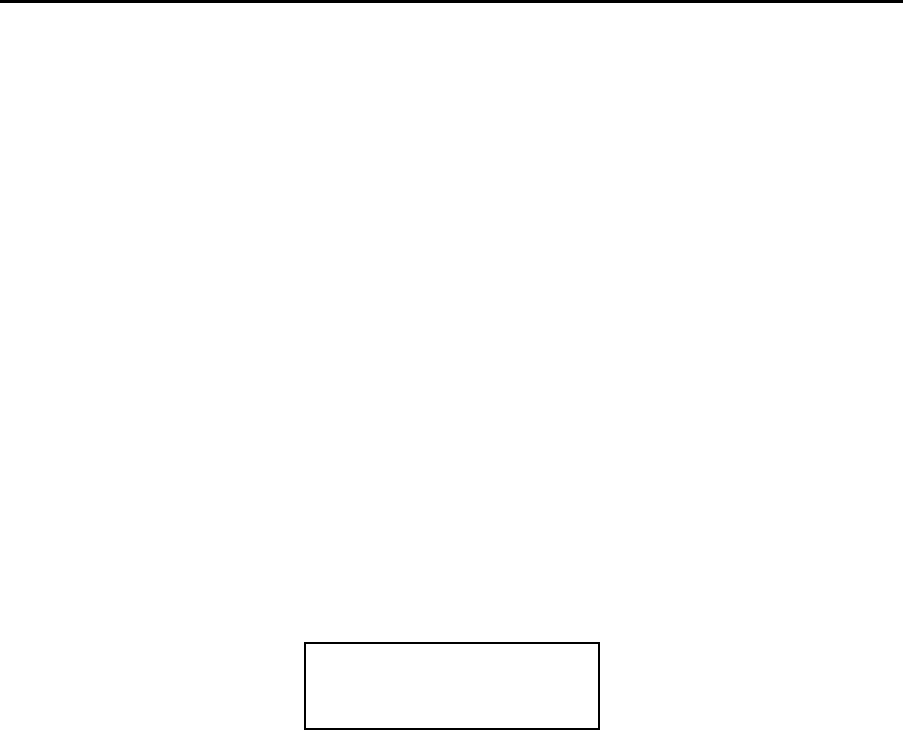
5
1.0/November 1998 1891 1210
Section 1
An overview
Wood & Douglas are an independent UK company dedicated to the design and
manufacture of high quality RF designs for the telemetry, security, broadcast and video
markets world-wide.
The information given in this manual is Copyright Wood & Douglas and is provided to
the original purchaser for the purposes of operation and routine maintenance. The
contents of this manual must not be disclosed to any third party, nor may the purchaser
make additional copies of the manual or store the information given on any electronic
retrieval or mass storage system.
The company reserves the right to amend or change specifications of its products
without prior notice in accordance with the company policy of continued product
improvement.
NOTE:
This device complies with Part 15 of the FCC Rules.
Operation is subject to the condition that this device does not cause harmful
interference.
The unit is labelled with a serial number label as shown below:
ST500 31 980912345
FCC ID ABCST500 CECE
where: 990912345 is the serial number of the unit containing the date code for
September 1998
ABC is the Wood & Douglas Ltd FCC code

6
1891 1210 1.0/November 1998
1.1 GENERAL DESCRIPTION
The ST500 can be configured for analogue or digital operation and is available in the
frequency range of 405 - 470MHz with a 12.5kHz channel spacing.
The transmitter requires a nominal 12 volt DC supply connected via PL7. However
the unit will function correctly within the limits of +6.0V to +14.0V. The output power
of the transmitter is normally preset to 100mW nominal.
The ST500 is intended to fit into OEM equipment housing by means of the three
connectors which protrude through the base of the unit.
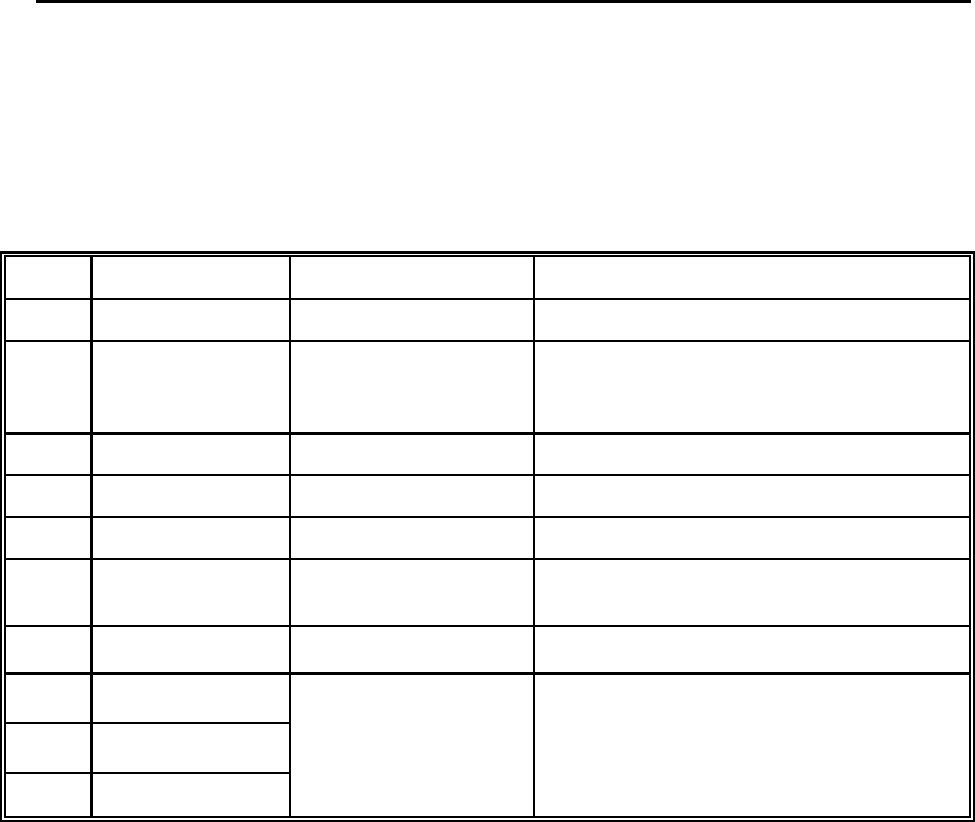
7
1.0/November 1998 1891 1210
Section 2
Operation
2.1 USER CONNECTIONS
Connection to the ST500 transmitter is made via three headers, PL1, PL2 and PL3,
which plug directly into the user's own equipment. The location of these connectors is
shown in the General Arrangement drawing given at the back of this manual.
The details of these three connectors are detailed below:
PIN NAME FUNCTION REMARKS
10V 0 volts common ground
2bTbXbEtransmit enable o/c = transmitter disabled
LOW <+0.8V = transmitter enabled
1KÙ nom. internal pull-up to +Vin
3DIGITAL I/P data input 0/+3V to 0/+12V, DC-coupled
4ANALOGUE I/P data input 300mV to 5V p-p, AC-coupled
5+5V O/P +5V supply output 50mA max. current drain
6RS232 I/P serial programming
input If not used leave un-connected or ground.
(refer to section 3.5 for details)
70V 0 volts common ground
8RB1 parallel frequency
select internal pull-up to +5V, active low
(refer to section 3.5.4 for details)
9RB2
10 RB3
Connector PL1 pin detail
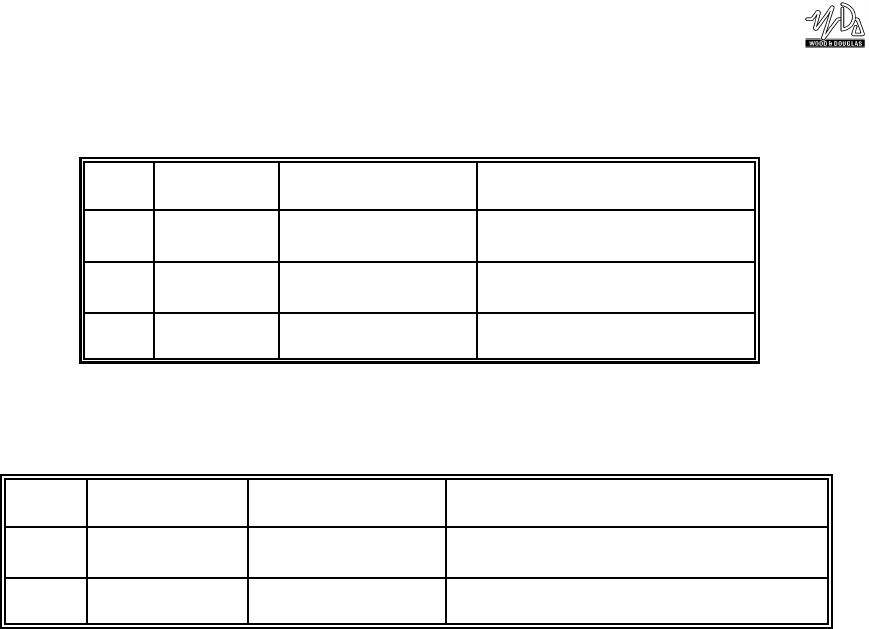
8
1891 1210 1.0/November 1998
PIN NAME FUNCTION REMARKS
10V 0 volts common ground
2RF O/P RF output 50 ohms output
30V 0 volts common ground
Connector PL2 pin detail
PIN NAME FUNCTION REMARKS
1+VIN positive supply +6.0V to +14.0V
20V 0 volts common ground
Connector PL3 pin detail

9
1.0/November 1998 1891 1210
Section 3
Technical description
Refer to the circuit diagram WD1632 at the rear of this manual.
3.1 POWER SUPPLY
DC power is connected to the transmitter module via PL3. The positive side of the supply
is fed to TR2 which acts as a series switch; when PL1 pin 2 is connected to 0V to enable
the transmitter then base current flows to TR2 via D6 and R54 and turns TR2 on. The
output from the collector of TR2 (‘+Vraw’) is fed to dual operational amplifier IC4, to TR3
collector (via chokes L5 and L6) and also to voltage regulator IC2. This regulator provides
a stable output of nominally +5V which is used to power all the remaining sections of the
transmitter (apart from IC7) either directly or via R-C decoupling networks.
3.2 INPUT INTERFACE
When the transmitter is to be used with an analogue modulation input then this input is fed
from PL1 pin 4 via R2 and C2 to RV1 in the feedback network around IC1a. RV1 acts as
an analogue gain control.
When the transmitter is to be used with a digital modulation input then this input is fed
from PL1 pin 3 via R1 to RV1 in the feedback network around IC1a. RV1 is set mid-way in
this application such that it has no effect; IC1a then functions as a comparator and
produces an output which swings between approximately +0.7V and +4.3V depending on
whether the digital input is low or high. These output levels are well-defined and result in
the modulation level being independent of the logic levels at the input to the transmitter.
3.3 MODULATION STAGE
The output from IC1a is fed to a low-pass filter built around IC1b. This restricts the
modulation bandwidth such that adjacent channel power levels are kept within
specification.
The output from IC1b is fed via R24 and RV2 to RV3 and R28. (C16 adds a further low-
pass filter stage at R24.) The modulation signal at the junction of RV2 and RV3 is fed to
the modulation input of the TCXO U1. The wiper of RV3 is connected via R31 to the
varicap diode D2 in the UHF oscillator.

10
1891 1210 1.0/November 1998
RV2 is connected as a variable resistor and consequently controls the amplitude of the
modulation signal to both oscillators; RV2 therefore sets the overall frequency deviation of
the transmitter.
RV3 controls the amplitude of the modulation signal to only the UHF oscillator. This
arrangement constitutes ‘dual-point modulation’; the modulation applied to the UHF
oscillator is only effective outside the bandwidth of the frequency control loop while that
applied to the TCXO is effective within this bandwidth. RV3 thus functions as a ‘deviation
balance’ control and is adjusted such that the overall modulation response is flat across its
full frequency range.
R28 is provided so that there is no significant change in the DC level fed to the modulation
input of the TCXO as RV2 is adjusted. (A DC shift would cause a corresponding shift in
the transmitter frequency.) In contrast, the DC voltage fed to the modulation input of the
UHF oscillator is allowed to change as RV3 is adjusted since this has no effect on the
mean transmitter frequency.
3.4 RADIO FREQUENCY STAGE
TR5 acts as a UHF oscillator whose frequency is determined primarily by L8, D3, D4 and
trimmer C32. D3 and D4 are varicap diodes and allow the oscillator to be tuned by means
of a DC voltage which is fed to the diodes via L9. Trimmer C32 provides coarse tuning of
the oscillator frequency.
Varicap diode D2 is also loosely coupled into the oscillator circuit via C26 and provides a
means of frequency-modulating the oscillator.
The output from the oscillator is developed across R42 at the collector of TR5 and is fed
via C40 to buffer amplifier IC5. This amplifier provides an increased output level while
isolating the oscillator from the rest of the circuit. The output from IC5 is fed through a
low-pass filter (C45, L12 and C48); the output from this filter is fed to the input of the
frequency synthesiser IC6 and also to buffer amplifier IC7.
Frequency synthesiser IC6 incorporates two programmable frequency dividers and an
edge-triggered phase comparator which is driven by the outputs of the two frequency
dividers. The division ratios are controlled by means of serial data generated by
microprocessor IC3. The filtered output from buffer amplifier IC5 is fed via C47 to the
input of one of the frequency divders at pin 8; the other input at pin 1 is driven by the
output of TCXO U1 via C28 and R33. The TCXO provides a reference frequency which is
very stable across the operating temperature range of the transmitter.
The phase comparator output from IC6 appears at pin 5 and is fed via R44 and R41 to L9
in the UHF oscillator. This completes the control loop and IC6 is thus able to control the
frequency of the UHF oscillator. R47 and C44 determine the dynamic behaviour of the
11
1.0/November 1998 1891 1210
control loop while C39 and C38 provide low-pass filtering at frequencies outside the
bandwidth of the control loop. This is necessary in order to filter out residual narrow
pulses which appear at the output of the phase comparator in IC6. C37 is provided for
decoupling purposes at RF frequencies.
IC6 also provides a ‘lock detect’ output at pin 7. This output is rectified and filtered by D1
and C23, then fed via R29 and R26 to pin 18 of microprocessor IC3. Pin 18 can function
as either an input or an output port; when IC3 is providing serial data to frequency
synthesiser IC6 then pin 18 acts as the data output port (‘DT’). Pins 17 and 12 provide
‘enable’ (‘EN’) and ‘clock’ (‘CK’) outputs which are also required by IC6 in conjunction with
the ‘DT’ output. The supply voltages to IC3 and IC6 are not identical, due to the separate
supply decoupling provided; resistors R26, R27 and R25 are therefore provided to ensure
that excessive current cannot flow under any conditions.
IC7 provides further amplification of the filtered output from IC5. However, its main
function is to provide further isolation between oscillator TR5 and the final output of the
transmitter; this is in order to minimise the effect of transmitter load changes on the
oscillator frequency. IC7 receives its DC power via microprocessor IC3; this allows IC7 to
act as a switch, in effect, so that there is negligible RF output from the transmitter in the
event that an out-of-lock condition is detected.
The output from IC7 is fed via C46 to the base of TR3 which functions as a common-
emitter amplifier, the emitter of TR3 being decoupled by C18 and C22. The output from
TR3 is developed across its collector choke L6 and is coupled via C27 to the base of
common-emitter amplifier TR4. The emitter of TR4 is decoupled by C24.
The output from TR4 is developed across its collector choke L7 and is fed via C19 and L4
to a low-pass filter comprised of C17, L3, C15, L2, C13, L1 and C10. The output from this
filter is fed to pin 2 of the RF output connector PL2.
The DC arrangements for TR3 and TR4 are as follows :
Operational amplifier IC4b provides a DC output of nominally +5.75V which is fed via
choke L11 to the base of TR3. The emitter of TR3 is thus held at approximately +5V
provided that the supply to IC4 (‘+Vraw’) is greater than +7V. TR4 takes its collector
supply voltage from the emitter of TR3 (via L7); it thus has a supply voltage which is
stabilised against variations in the input supply voltage to the transmitter module.

12
1891 1210 1.0/November 1998
Microprocessor IC3 provides an output at pin 11 (‘+Vtx’) when the transmitter is enabled
and no out-of-lock condition is detected. This output is a stepped voltage ramp (which
limits at +5V) and is fed via R45 to potentiometer RV4. C43 smooths out the steps in the
voltage ramp. The wiper of RV4 is connected to the non-inverting input of operational
amplifier IC4a. The inverting input of IC4a is connected to the emitter of TR4 while the
output of IC4a is fed via D5 and R36 to the base of TR4. This has the effect of forcing the
emitter voltage of TR4 to track the voltage ramp at the wiper of RV4. The current in TR4
is thus ramped up at the beginning of a transmission (and ramped down at the end) and
consequently the RF output power from the transmitter is similarly ramped up and down.
The setting of RV4 determines the RF output power level. D5 and R38 provide a DC level
shift at the output of IC4a, thereby permitting TR4 to be effectively controlled down to very
low levels.
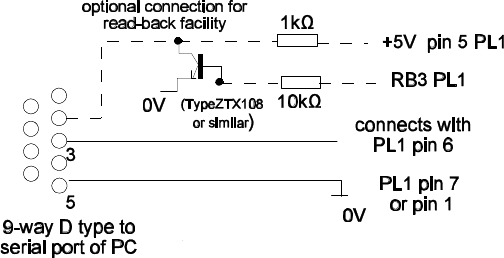
13
1.0/November 1998 1891 1210
Figure 2 Programming adaptor
3.5 FREQUENCY PROGRAMMING
3.5.1 Introduction
The ST500 has an internal memory which can store up to 128 RF channels (16 randomly
programmed and 112 sequentially programmed). The frequency and set-up information is
programmed into the unit by a synchronous PCM interface protocol.
The software supplied with the ST500 transmitter is the ST500PRG.exe program. The
software can be run on a PC with the serial port connected to PL1 of the ST500
transmitter via a suitable adaptor as shown in Figure 2. If the read-back function is
desired, then PL1 pin 10 of the transmitter must be connected to pin 2 of the PC serial
port via a buffer circuit. A 1k pull-up resistor to +5V must also be provided as shown.
3.5.2 Running the Software
1. Connect ST500 to a suitable supply and to the PC using the programming adaptor.
2. Insert the ST500PRG disk into drive A and type:
A:ST500PRG <return> then type:
3. The user is then prompted to enter the serial port number of his PC which is used
to communicate with the ST500 receiver. Enter 1 or 2.
After the software has successfully loaded the main menu screen is displayed as shown in
Figure 3. The screen shows the default settings which are entered at factory set-up.
These default settings will be displayed whenever the ST500PRG software is run.
Please note that mouse operation is not supported with this program.

14
1891 1210 1.0/November 1998
ST500 Programmer
Synth. step freq. 12.5 KHz
Chan 0 458.5 MHZ <<
Chan 1 458.5125 MHz Ref. (TCXO) freq. 12.8 MHz
Chan 2 458.525 MHz
Chan 3 458.5375 MHz
Chan 4 458.55 MHz Serial channel selected: 0
Chan 5 458.5625 MHz
Chan 6 458.575 MHz COMMANDS:
Chan 7 458.5875 MHz
Chan 8 458.6 MHz F2 :copy Ch 16-31 to Ch 0-15
Chan 9 458.6125 MHz F5 :read from unit
Chan 10 458.625 MHz F6 :program unit
Chan 11 458.6375 MHz F8 :Select channel
Chan 12 458.65 MHz
Chan 13 458.6625 MHz F9 :set synth. step freq.
Chan 14 458.675 MHz F10 :set TCXO freq.
Chan 15 458.6875 MHz F11 :set Intermediate freq.
F12 :QUIT
Start table 458.7 MHZ
Max. Freq. 458.95 MHz Sequential frequencies, Chan. 16 to 127
Table step 1 x 12.5 KHz
Figure 3
NOTES:
1. The synthesizer step frequency, the reference (TXCO) frequency and the
intermediate frequency are non-programmable.
2. Functions F9, F10 and F11 are not enabled.
3. Function F5 is only enabled when a read-back programming adaptor is used, (refer
to Figure 2). This function displays the current frequency table of the connected
ST500 receiver.
4. A value for each parameters has to be entered.
5. Only channel 0 to 15 frequencies can be displayed by this software
3.5.3 Serial Channel Selection
The unit defaults to serial channel selection whenever the software is run. Selecting the
F8 function key prompts the user to enter the new serial channel number which is then
displayed in ‘Serial channel selected’.
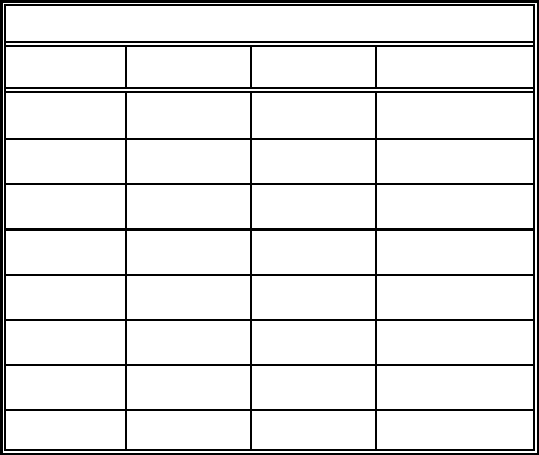
15
1.0/November 1998 1891 1210
3.5.4 Parallel Channel Selection
To enable parallel channel selection mode select the F8 (Select channel) function key and
then enter ‘999' as the new frequency. The screen then displays ‘parallel mode selected’.
Three inputs RB1, RB3 and RB3 applied via PL1 to pin 8, pin 9 and pin 10 respectively,
select the operating channel as shown in the following table:
CHANNEL SELECTION
PIN 8 PIN 9 PIN 10 CHANNEL
LOW LOW LOW 7
LOW LOW HIGH 6
LOW HIGH LOW 5
LOW HIGH HIGH 4
HIGH LOW LOW 3
HIGH LOW HIGH 2
HIGH HIGH LOW 1
HIGH HIGH HIGH 0
The logic levels are: LOW = < 0.8V,
HIGH = > 2V or floating
3.5.5 Programming Random Channels
Random channels between 0 and 15 can be entered using the Up 8 and Down 9 arrow
keys and then entering the required operating frequency. The entered value must be an
integer multiple of 12.5kHz otherwise an ‘invalid’ message is displayed.

16
1891 1210 1.0/November 1998
3.5.6 Programming Sequential Channels
To generate a new frequency table the following parameter values must be entered:
- start frequency
- the maximum frequency
- the table step as a multiple of 12.5kHz.
The maximum frequency is calculated from the start table frequency and the table step..
Therefore if the calculation exceeds the maximum frequency then this parameter will be
increased automatically.
When the frequency table has been generated the user then selects F6 to program the
unit.
The function key F2 can be used to copy the contents of channel 16-31 to channel 0 - 15
to ease sequential programming.
3.5.7 Programming from Customer Equipment
In the event of a customer wishing to program the ST500 receiver from his own equipment
then the following data sequence must be used allowing 5ms between the characters in
the data stream:
1200 baud, RS232 interface, 1 start bit - 8 bit data - no parity - 1 stop bit
40 (decimal 64) synchronising code
7 bit channel 0 - 127 (bit 7 = 0)
95 (decimal 149) confirmation byte
17
1.0/November 1998 1891 1210

18
1891 1210 1.0/November 1998
Section 4
Technical specifications
Frequency range :405 - 470 MHz
Switching bandwidth :8 MHz
Frequency stability : +/-2ppm
Number of RF channels :up to 128 (16 randomly programable, 112
sequential), serial select/reprogram, 1200 baud
RS232 or
1 of 8 parallel select
RF output power into 50 ohm :100 mW adjustable to 5mW
:1 - 10 mW version available
Adjacent channel power :<200nW (-37dBm)
TX switching time :<60 mS
Modulation input
analogue : 200 mV to 5V p-p AC coupled
digital :+3 to 12V square wave DC coupled
Frequency response :9Hz to 3kHz at -3dB
Deviation :+/-1.5kHz nom (±2.5kHz max)
Channel switching delay :<50mS across switching bandwidth
Channel spacing :12.5kHz
Modulation type :F1D/F2D/F3D
Spurious emissions
(conducted & radiated) :in accordance with ETS/CEPT specifications
Supply voltage :6 - 15V DC -ve earth
Supply current at 7.2V :<100mA for 100mW output
Interface connections :2 and 10 pin 0.1" header
RF connection :3 pin 0.1" header
Operating temperature :-20oC to +55oC
Storage temperature :-30oC to +70oC
Size overall :60 x 39 x 15 mm
Weight :30gm
Type approval :designed to meet ETS 300 220
General facilities :+5V output
:analogue and digital inputs